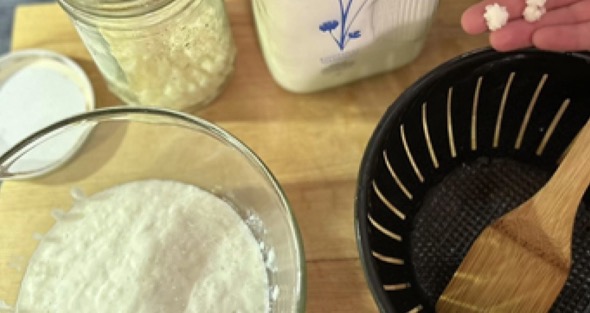Kefir

EQUIPMENT
- Plastic strainer (no metal)
- Glass bowl (choose a size that will fit the bottom of strainer)
- Wooden spoon
- Glass jar
INGREDIENTS
- Kefir grains
- Organic A2 Milk
METHOD
For dairy kefir, the grains are stored in milk – the milk sugars are their food. Given time to ferment, the dairy product it creates is the kefir.
Discard the kefir from the first harvest from your new grains, or grains that are being reactivated after a prolonged dormancy.
Kefir and its grains should not be in contact with metal – so always use wood, plastic or your hands when working with it.
To harvest:
- Place a plastic strainer on top of a glass bowl to collect the fermented dairy
- Pour all contents from your jar into the strainer.
- This collected kefir is a finished product
To prepare the grains for the next batch:
- With the grains in the strainer, rinse them with water; use the wooden spoon and stir to clean
- With your bare/clean hands, squeeze out excess water. Don’t squeeze too hard.
- Grains are alive when they feel spongy; if they turn to mush, they are dead
- Clean the glass jar thoroughly. Hot water is sufficient to do this; do not use harsh soap
- Add the grains to the warm jar and cover with dairy by about 2 inches.
- Cap the jar and place on the counter for 24 hours to ferment or “culture”
- Kefir is ready when the dairy appears thick
- When it reaches the desired consistency/potency, it’s time to collect as described above
Kefir tastes best when served cold, although room temperature is also fine and just a matter of preference.
For serving suggestions, add it as a base for your smoothies. Take care not to over-blend as this can change the molecular structure. If you find it too tart, sprinkle with a little sea salt.

Kefir [From Milk]
Another Great ‘Psychobiotic’ – Kefir
Kefir grains are a living organic culture made up of proteins, sugars, and fats, and contain living colonies of various yeasts and bacteria existing in a symbiotic relationship. It’s a healthy fermented food with a consistency comparable to drinkable yogurt.
With its multiple lacto probiotic strains – Kefir is packed with a great dose of healthy bacteria that helps address inflammation and gut health generally. Kefir is a complete protein, and is packed with Vitamins K2, D, B 12, B2, Calcium, Magnesium as well as yeast balancing bacteria and its healthy bacteria profile is far more powerful than yogurt.
In addition, there is evidence of probiotics’ ability to address weakened immune systems, digestive issues including overgrowth of yeast (candida), bone health, increased bowel motility, and decreased systemic inflammation.
For your gut health, Kefir complements what you’re achieving with the gut-lining effects delivered by meat stock and other collagen-rich foods. Probiotics address the balance of the flora in your increasingly healthy gut environment. Read more here.
Kefir is a very powerful probiotic; you will need to work up to a full glass by listening and responding to your body’s needs. Start slowly with only a few tablespoons, then move to a quarter cup, then to half a cup, etc. If you have had too much, you will experience diarrhea. Back off the amount, then continue slowly.
Note about A2 dairy. This recipe calls for A2 dairy. Dairy gets the label of A1 or A2 depending on the type of protein (typically a strain of casein) it has. Milk common to North America most commonly contains both A1 beta-casein and A2. If you can find it, dairy with only A2 (such as that produced by Jersey/Guernsey cows) is considered a cleaner and more digestible choice of dairy. There are a number of producers of A2 milk in Canada – and clearly marked as such. Check your local natural foods store to ask a valued customer care person to guide you to A2 dairy products.
Note about Kefir grains. You can find live Kefir grains in a number of places – such as ordering from a reputable dealer on Amazon, from any natural food store and, I just saw, they’re available in some Walmart stores.
When you receive your grains, they will be in milk. The lactose sugar in the dairy feeds the grains; that is how they grow and survive. Water will kill the grains, therefore keep grains in dairy at all times. When you need to store your grains (like when on holidays), give your grains plenty of dairy and store them in the fridge. They will last for a long time. This product is traditionally made from dairy milk, but there are many non-dairy options as well.
At the beginning, you will have few grains which are best housed in a small jar. As your grains grow and proliferate, you will need to graduate to larger jars. Eventually, your colony will be too large for just you to harvest and use. That’s when you separate them, and gift a colony to someone who would appreciate the healing effects they offer.